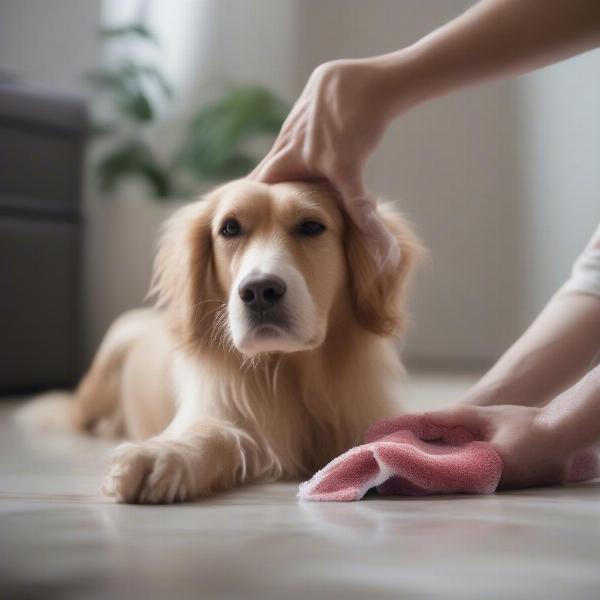Sticky paws in dogs can be caused by a variety of factors, from environmental elements like tree sap or sticky foods to underlying medical conditions. Knowing how to identify the cause and address it promptly is essential for your dog’s comfort and well-being. This article will guide you through the causes, solutions, and preventative measures for sticky paws in dogs.
Identifying the Cause of Your Dog’s Sticky Paws
The first step in managing sticky paws is determining the culprit. Is it something obvious like syrup or honey? Or could it be something more subtle? Common causes include:
- Food and Treats: Sweet, sticky treats or spilled food are often the easiest to identify.
- Environmental Substances: Tree sap, tar, glue, or even chewing gum can adhere to your dog’s paws.
- Medical Conditions: Certain medical conditions can cause excessive sweating or discharge, leading to sticky paws.
- Allergies: Allergies can cause inflammation and itching, prompting your dog to lick their paws excessively, resulting in stickiness.
Cleaning Your Dog’s Sticky Paws: A Step-by-Step Guide
Once you’ve identified the cause, you can begin the cleaning process. Here’s a step-by-step guide:
- Gather your supplies: You’ll need warm water, a gentle dog shampoo, a soft towel, and potentially some cotton balls or a washcloth. For stubborn substances like tar, you may need cooking oil or peanut butter.
- Restrain your dog gently: Ensure your dog is comfortable and secure to prevent them from moving during the cleaning process.
- Soak the affected paws: If the substance is water-soluble, soak the paws in warm water for a few minutes to loosen it.
- Apply dog shampoo: Gently lather the affected area with dog shampoo and massage it in.
- Remove the sticky substance: Use your fingers, a washcloth, or cotton balls to gently remove the substance. For sticky substances like tar, apply cooking oil or peanut butter to help break it down before washing.
- Rinse thoroughly: Make sure all traces of shampoo and the sticky substance are removed.
- Dry the paws: Pat the paws dry with a soft towel.
 Cleaning a dog's sticky paws
Cleaning a dog's sticky paws
Preventing Sticky Paws
While cleaning sticky paws is relatively straightforward, prevention is always the best approach. Consider the following:
- Supervise feeding: Monitor your dog during mealtimes and clean up any spills immediately.
- Avoid sticky treats: Opt for less sticky treats or offer them in a bowl to minimize paw contact.
- Paw protection: Consider using dog booties or paw wax when walking in areas with potential sticky substances like tree sap or tar.
- Regular paw checks: Regularly inspect your dog’s paws, especially after walks, to catch any stickiness early on.
- Address underlying medical conditions: If you suspect a medical condition is contributing to sticky paws, consult your veterinarian.
When to Consult a Veterinarian
While sticky paws are often easily resolved at home, sometimes veterinary intervention is necessary. Consult your veterinarian if:
- You can’t identify the cause of the stickiness.
- Your dog’s paws are red, swollen, or painful.
- The stickiness persists despite cleaning efforts.
- Your dog exhibits other symptoms like excessive licking, chewing, or limping.
Conclusion
Sticky paws in dogs can be a nuisance, but with proper identification, cleaning, and preventative measures, you can keep your furry friend’s paws clean and comfortable. Regular paw checks and prompt action are key to ensuring your dog’s overall health and well-being. Don’t hesitate to consult your veterinarian if you have any concerns.
FAQ
- My dog’s paws are sticky and smell bad. What could be the cause? This could be a sign of a bacterial or yeast infection. Consult your veterinarian for diagnosis and treatment.
- Can I use human hand soap to clean my dog’s sticky paws? It’s best to use a dog-specific shampoo as human soaps can be too harsh for their skin.
- My dog keeps licking his paws after I clean them. What should I do? This could indicate an underlying allergy or irritation. Consult your veterinarian.
- What type of paw wax is best for preventing sticky paws? Look for a natural, non-toxic paw wax that is safe for dogs.
- How often should I check my dog’s paws? Daily paw checks are recommended, especially after walks.
ILM Dog is your trusted resource for comprehensive dog care information. We offer expert advice on dog breeds, health, training, nutrition, grooming, and more. From puppy care to senior dog care, we’re here to support you every step of the way. Contact us at [email protected] or +44 20-3965-8624. ILM Dog is committed to providing dog owners with the knowledge and resources they need to provide the best possible care for their canine companions.